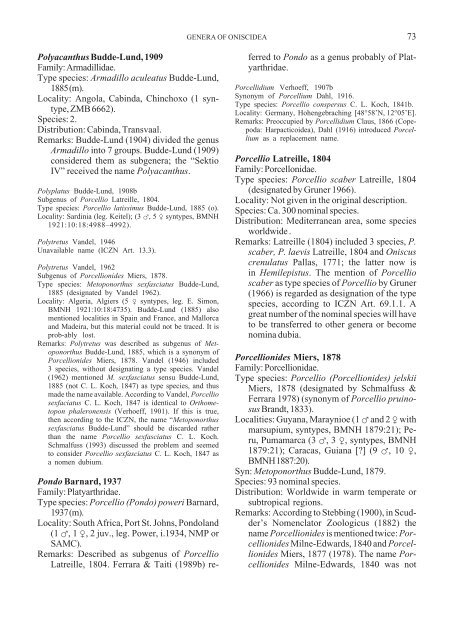Catalogue of genera of the terrestrial Isopoda
Catalogue of genera of the terrestrial Isopoda
Catalogue of genera of the terrestrial Isopoda
You also want an ePaper? Increase the reach of your titles
YUMPU automatically turns print PDFs into web optimized ePapers that Google loves.
Polyacanthus Budde-Lund, 1909<br />
Family: Armadillidae.<br />
Type species: Armadillo aculeatus Budde-Lund,<br />
1885 (m).<br />
Locality: Angola, Cabinda, Chinchoxo (1 syntype,<br />
ZMB 6662).<br />
Species: 2.<br />
Distribution: Cabinda, Transvaal.<br />
Remarks: Budde-Lund (1904) divided <strong>the</strong> genus<br />
Armadillo into 7 groups. Budde-Lund (1909)<br />
considered <strong>the</strong>m as sub<strong>genera</strong>; <strong>the</strong> “Sektio<br />
IV” received <strong>the</strong> name Polyacanthus.<br />
Polyplatus Budde-Lund, 1908b<br />
Subgenus <strong>of</strong> Porcellio Latreille, 1804.<br />
Type species: Porcellio latissimus Budde-Lund, 1885 (o).<br />
Locality: Sardinia (leg. Keitel); (3 �, 5 � syntypes, BMNH<br />
1921:10:18:4988–4992).<br />
Polytretus Vandel, 1946<br />
Unavailable name (ICZN Art. 13.3).<br />
Polytretus Vandel, 1962<br />
Subgenus <strong>of</strong> Porcellionides Miers, 1878.<br />
Type species: Metoponorthus sexfasciatus Budde-Lund,<br />
1885 (designated by Vandel 1962).<br />
Locality: Algeria, Algiers (5 � syntypes, leg. E. Simon,<br />
BMNH 1921:10:18:4735). Budde-Lund (1885) also<br />
mentioned localities in Spain and France, and Mallorca<br />
and Madeira, but this material could not be traced. It is<br />
prob-ably lost.<br />
Remarks: Polytretus was described as subgenus <strong>of</strong> Metoponorthus<br />
Budde-Lund, 1885, which is a synonym <strong>of</strong><br />
Porcellionides Miers, 1878. Vandel (1946) included<br />
3 species, without designating a type species. Vandel<br />
(1962) mentioned M. sexfasciatus sensu Budde-Lund,<br />
1885 (not C. L. Koch, 1847) as type species, and thus<br />
made <strong>the</strong> name available. According to Vandel, Porcellio<br />
sexfaciatus C. L. Koch, 1847 is identical to Orthometopon<br />
phaleronensis (Verhoeff, 1901). If this is true,<br />
<strong>the</strong>n according to <strong>the</strong> ICZN, <strong>the</strong> name “Metoponorthus<br />
sexfasciatus Budde-Lund” should be discarded ra<strong>the</strong>r<br />
than <strong>the</strong> name Porcellio sexfasciatus C. L. Koch.<br />
Schmalfuss (1993) discussed <strong>the</strong> problem and seemed<br />
to consider Porcellio sexfasciatus C. L. Koch, 1847 as<br />
a nomen dubium.<br />
Pondo Barnard, 1937<br />
Family: Platyarthridae.<br />
Type species: Porcellio (Pondo) poweri Barnard,<br />
1937 (m).<br />
Locality: South Africa, Port St. Johns, Pondoland<br />
(1 �, 1 �, 2 juv., leg. Power, i.1934, NMP or<br />
SAMC).<br />
Remarks: Described as subgenus <strong>of</strong> Porcellio<br />
Latreille, 1804. Ferrara & Taiti (1989b) re-<br />
GENERA OF ONISCIDEA<br />
73<br />
ferred to Pondo as a genus probably <strong>of</strong> Platyarthridae.<br />
Porcellidium Verhoeff, 1907b<br />
Synonym <strong>of</strong> Porcellium Dahl, 1916.<br />
Type species: Porcellio conspersus C. L. Koch, 1841b.<br />
Locality: Germany, Hohengebraching [48°58’N, 12°05’E].<br />
Remarks: Preoccupied by Porcellidium Claus, 1866 (Copepoda:<br />
Harpacticoidea), Dahl (1916) introduced Porcellium<br />
as a replacement name.<br />
Porcellio Latreille, 1804<br />
Family: Porcellonidae.<br />
Type species: Porcellio scaber Latreille, 1804<br />
(designated by Gruner 1966).<br />
Locality: Not given in <strong>the</strong> original description.<br />
Species: Ca. 300 nominal species.<br />
Distribution: Mediterranean area, some species<br />
worldwide .<br />
Remarks: Latreille (1804) included 3 species, P.<br />
scaber, P. laevis Latreille, 1804 and Oniscus<br />
crenulatus Pallas, 1771; <strong>the</strong> latter now is<br />
in Hemilepistus. The mention <strong>of</strong> Porcellio<br />
scaber as type species <strong>of</strong> Porcellio by Gruner<br />
(1966) is regarded as designation <strong>of</strong> <strong>the</strong> type<br />
species, according to ICZN Art. 69.1.1. A<br />
great number <strong>of</strong> <strong>the</strong> nominal species will have<br />
to be transferred to o<strong>the</strong>r <strong>genera</strong> or become<br />
nomina dubia.<br />
Porcellionides Miers, 1878<br />
Family: Porcellionidae.<br />
Type species: Porcellio (Porcellionides) jelskii<br />
Miers, 1878 (designated by Schmalfuss &<br />
Ferrara 1978) (synonym <strong>of</strong> Porcellio pruinosus<br />
Brandt, 1833).<br />
Localities: Guyana, Maraynioe (1 � and 2 � with<br />
marsupium, syntypes, BMNH 1879:21); Peru,<br />
Pumamarca (3 �, 3 �, syntypes, BMNH<br />
1879:21); Caracas, Guiana [?] (9 �, 10 �,<br />
BMNH 1887:20).<br />
Syn: Metoponorthus Budde-Lund, 1879.<br />
Species: 93 nominal species.<br />
Distribution: Worldwide in warm temperate or<br />
subtropical regions.<br />
Remarks: According to Stebbing (1900), in Scudder’s<br />
Nomenclator Zoologicus (1882) <strong>the</strong><br />
name Porcellionides is mentioned twice: Porcellionides<br />
Milne-Edwards, 1840 and Porcellionides<br />
Miers, 1877 (1978). The name Porcellionides<br />
Milne-Edwards, 1840 was not

















